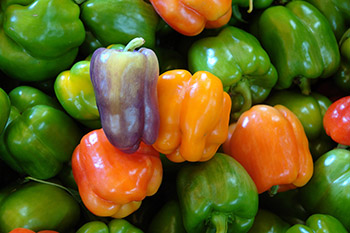Bell Peppers Description & Health Benefits
 Bell peppers belong to the Solanaceae botanical family which also includes potato, eggplant, tomato, tomatillo, ground cherry, chili peppers and tobacco, among others.
Bell peppers belong to the Solanaceae botanical family which also includes potato, eggplant, tomato, tomatillo, ground cherry, chili peppers and tobacco, among others.- Bell peppers are also known as pepper, sweet pepper or capsicum.
- Bell peppers come in a variety of colors, including green, yellow, orange, red, purple and even white and brown. Green and purple peppers have a more bitter taste, while the yellow, orange and red have a sweeter taste.
- Bell peppers are an excellent source of vitamin C and vitamin B6:
- Vitamin C is an antioxidant that repairs and maintains cartilage, bones, and teeth while also assisting in healing wounds and forming scar tissue.
- Vitamin B6 is involved in protein metabolism, brain development during pregnancy and immune function.
- Bell peppers also contain antioxidants including carotenoids and flavonoids which are beneficial by reducing
the risk of cancer and cardiovascular disease.
Purchasing, Selecting, Storing, and Preparing
- Purchase bell peppers year round in a grocery store or seasonally at a farmer’s market.
- Select bell peppers that are firm and heavy, and the skin should be smooth and free from blemishes and bruises.
- Store in the refrigerator for up to one week prior to use.
- Prepare bell peppers by washing before use. Remove the stem, seeds and the white membrane, or pith, from the inner part of the pepper. Cut into strips, rings or dice into squares.
- Bell peppers can be frozen for later use. To do so, slice or dice and freeze raw. They do not need to be blanched prior to freezing. Use frozen peppers within eight months of freezing for best taste.
- Bell peppers can be eaten raw or cooked. Try them roasted, baked or sautéed.
Nutrition Facts
1 large, raw, mixed bell pepper
Calories: 30 | Protein: 1.01 g | Fat: 0.0 g | Carbohydrate: 7.0 g | Fiber: 2.1 g | Calcium: 21 mg | Iron: 0.36 mg | Vitamin C: 114.0 mg | Vitamin A: 400.0 IU
ndb.nal.usda.gov
Recipes
Request an Appointment
